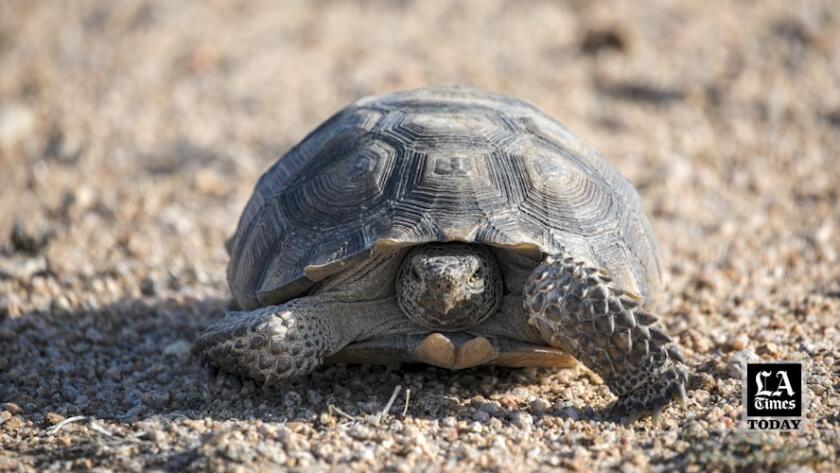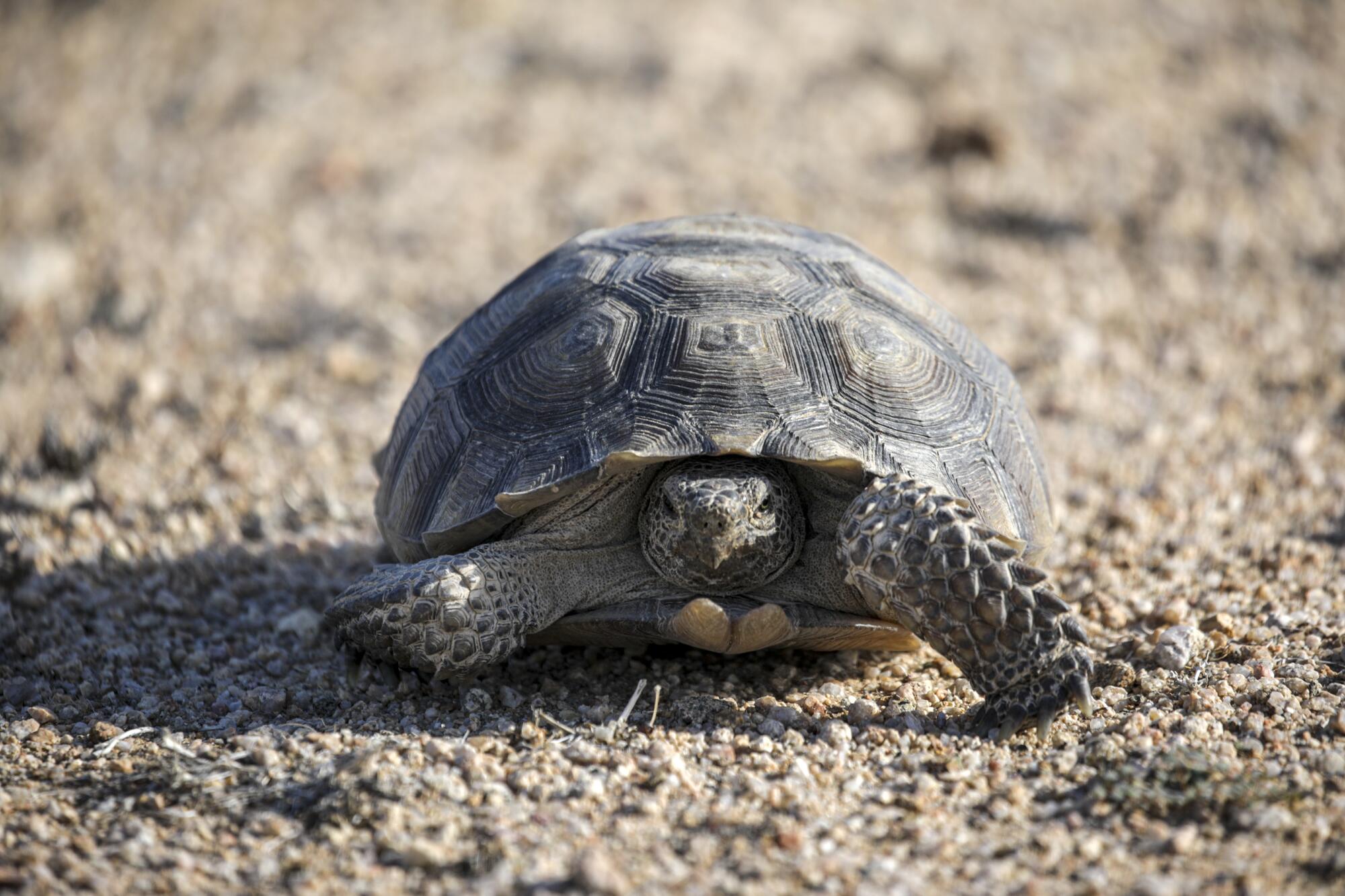
CALIFORNIA CITY, Calif. — Behind the fences surrounding this 40-square-mile outback of cactus and wiry creosote, the largest remaining population of Mojave desert tortoises was soaking up the morning sun and grazing on a mix of wild greens and flowers.
But that didn’t mean the armored beasts were easy to find in a tiny spit of sand that Congress voted to protect in 1980 and designated with a name only herpetologists could love: Desert Tortoise Research Natural Area.
After a few hours of searching in late September, naturalist Lisa LaVelle tramped down a narrow path — past thorny brush that hid rattlesnakes and scorpions — and fixed her eyes on a tortoise the size of a shoebox.
She scanned its carapace for a GPS tracker or an identification tag. After spotting neither, she smiled and said, “Well, hello there! I don’t believe we’ve met before.”
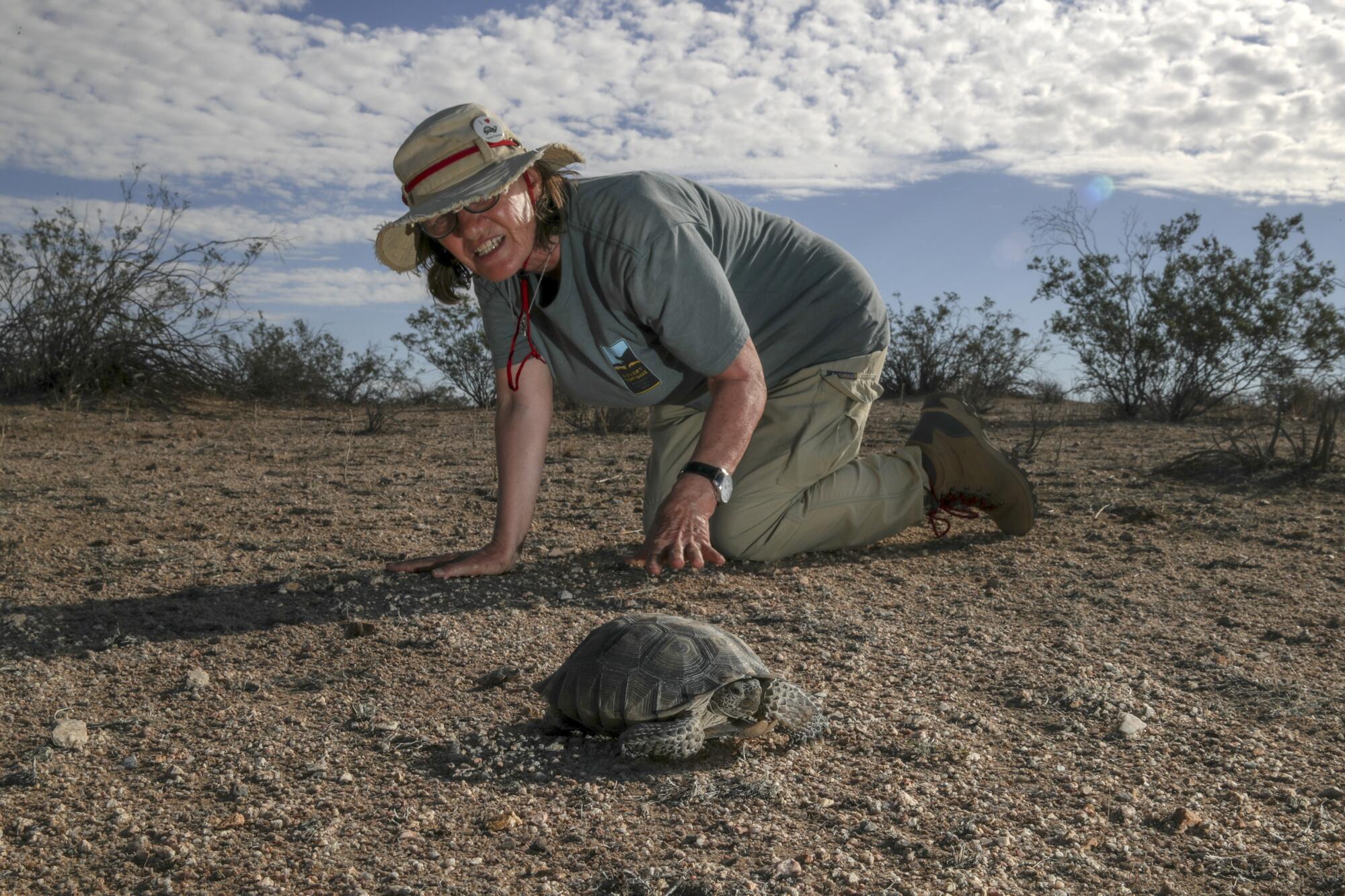
LaVelle, who is part of a team charged with monitoring the overall health of the area’s tortoises, was elated by the discovery. “We have one more tortoise than we thought we had,” she said. “That’s great news for us and a species that needs all the help it can get.”
Sadly, California’s state reptile is hurtling toward extinction. Crushing vehicle strikes, urban encroachment, hungry ravens, military maneuvers, disease, drought, extreme heat, wildfires, illegal marijuana grows and development of massive solar farms are all pushing the species to the brink.
Eight decades ago, the vast Mojave Desert was home to hundreds of tortoises per square mile, with the reptiles inhabiting nearly all areas of the desert below an altitude of 3,000 feet. Today, most tortoise populations in California and outside designated recovery areas have fallen to 2 to 3 adults per square mile — too few for male and female tortoises to find each other and mate, researchers say.

Eight decades ago, the Mojave Desert was home to hundreds of tortoises per square mile. Today, most tortoise populations in the wild have fallen to 2 to 3 adults per square mile, largely due to climate change, loss of habitat and an increase in the raven population. Can California’s Endangered Species Act save the tortoises from extinction?
It’s the type of precipitous decline that spurred state lawmakers to adopt the California Endangered Species Act in 1970. The landmark legislation — which grants broad protections to plant and animal species that are deemed endangered or threatened by the state Fish and Game Commission — predated the U.S. Endangered Species Act by three years.
“Over time, the California Endangered Species Act evolved parallel to and in a symbiotic relationship with the federal government’s,” said Brendan Cummings, conservation director for the Center for Biological Diversity. “They influenced each other in changes in substance and implementation of endangered species protections.”
Though both laws have been credited with helping to rescue such charismatic avian species as the California condor, bald eagle and peregrine falcon, global warming and human encroachment are outpacing the laws’ ability to safeguard certain plants and animals.
Although Gopherus agassizii was listed as threatened under the California law in 1989 and the federal law the following year, those protections have done little to improve the dire prognosis for the benign herbivores with weary eyes.
Hoping to reverse the very real likelihood that the species will become extinct, the Defenders of Wildlife, the Desert Tortoise Council and the Desert Tortoise Preserve Committee have filed a petition urging the California Fish and Game Commission to elevate its status from threatened to endangered. A final decision is expected later this year.
“With new climate change threats not foreseen when CESA was enacted, we have to do better,” said Laura Cunningham, California director at Western Watersheds Project, a nonprofit conservation group dedicated to protecting native species and restoring habitats they depend on.
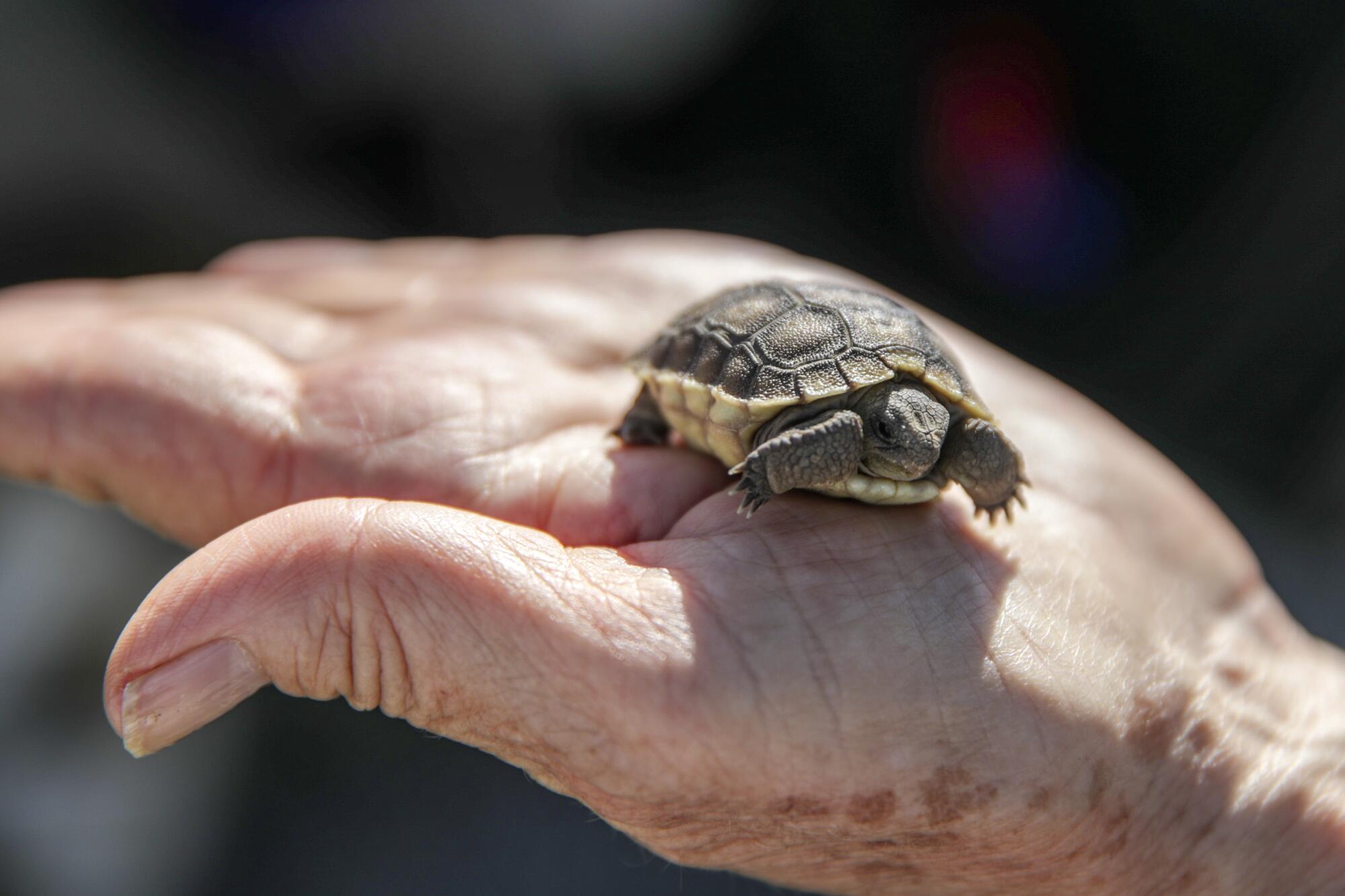
State officials and conservationists acknowledge that there is no significant difference in the legal protections offered to species listed as threatened or endangered. However, endangered species have higher priority and funding for conservation measures such as public outreach, habitat protection, recovery efforts and mitigation measures to compensate for habitat losses due to massive construction projects.
“Elevating the species’ status to endangered wouldn’t bring development in the desert to a halt,” said Jun Lee, director of the Desert Tortoise Preserve Committee. “But it would help raise funds for recovery efforts and make a big difference in getting developers to provide compensation for the habitat they disturb.”
California typically requires developers to provide two to three acres of suitable tortoise habitat for every acre taken. Solar developers may pay to close off-road vehicle routes, rehabilitate degraded habitat, fund public education programs, translocate tortoises, and erect miles of special fencing to keep the tortoises off highways and out of solar energy facilities.
No state has had a bigger impact on the direction of the United States than California, a prolific incubator and exporter of outside-the-box policies and ideas. This occasional series examines what that has meant for the state and the country, and how far Washington is willing to go to spread California’s agenda as the state’s own struggles threaten its standing as the nation’s think tank.
But efforts to meet California’s ambitious energy goals have heightened conflicts between the tortoise and large-scale solar energy facilities and electrical transmission corridors.
There are more than a dozen solar energy facilities operating in the Mojave Desert, and an estimated 15 more have been approved for development.
Under the current system, the cost of developing a comprehensive wildlife-protection plan falls most heavily on the developer who had to undertake expensive mitigation, often with the help of biological consultants who are paid up to $1,000 per day to assist in capturing and relocating local tortoises to land set aside for them elsewhere.
Despite promises to do so, critics say, state and federal wildlife and land management agencies often fail to devote enough money and staff to ensure that all goes as planned, hastening the disappearance of a species that has been roaming Southern California’s desert for thousands of years.

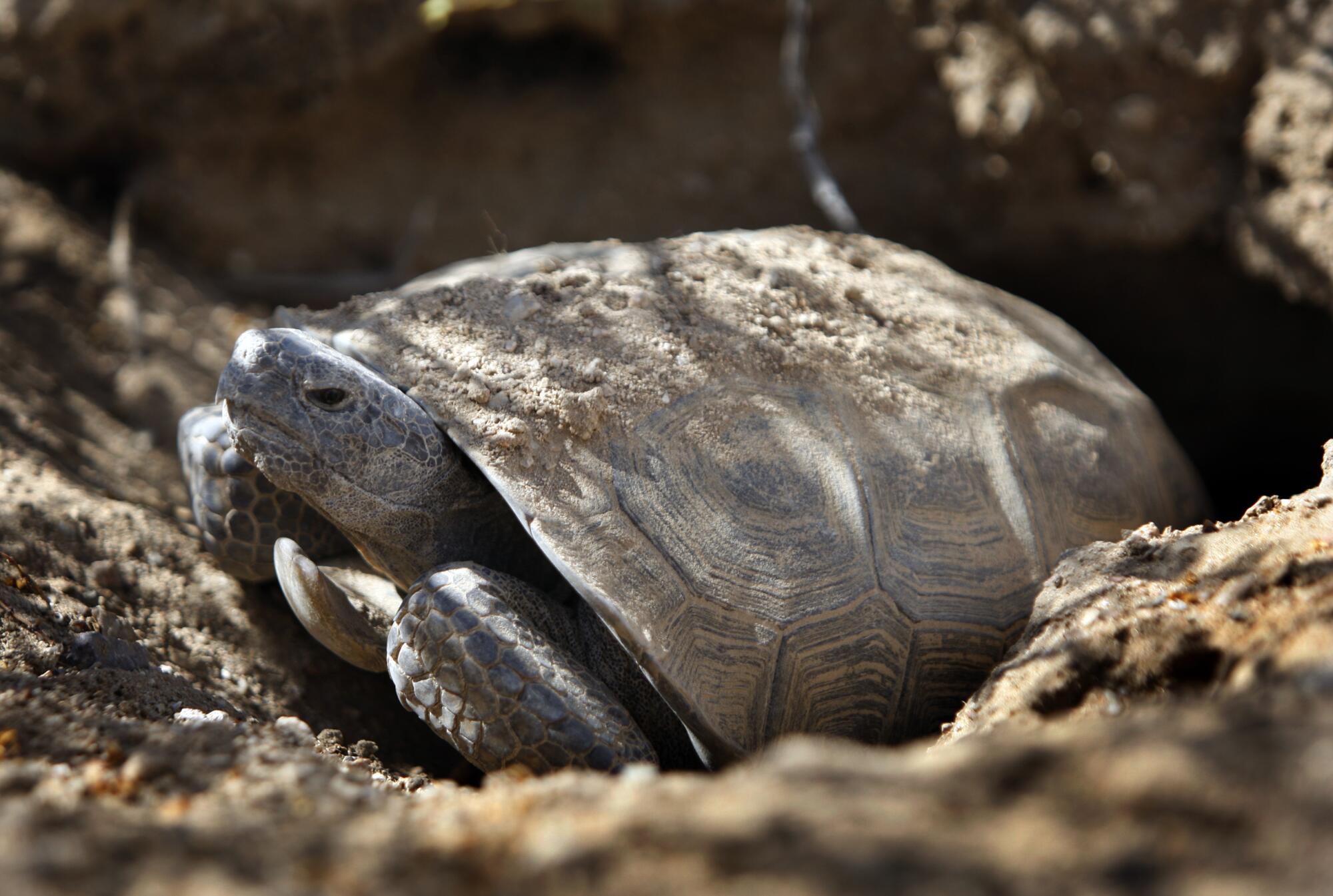
At the $2.2-billion BrightSource Energy solar farm in Ivanpah Valley, just west of the Nevada border, construction was halted for three months in 2012 due to an unforeseen calamity: Excavation work found far more tortoises than biologists expected.
Although BrightSource had already spent $56 million to protect and relocate 166 adult and juvenile tortoises, some animals were squashed by vehicles, while ants attacked hatchlings in a makeshift nursery and an eagle carried off a juvenile tortoise as a microchip embedded in its shell pinged ever more faintly on its journey to the raptor’s nest.
Last summer, federal wildlife biologists relocated 139 Mojave desert tortoises from a solar farm that was under construction near Pahrump, in southern Nevada. Less than three weeks later, 30 of those tortoises were believed to have been killed by badgers, according to emails that conservationists obtained through a public records request.
Although sheathed like a battle tank, the tortoise was not well adapted to harsh, arid landscapes. It evolved millions of years ago when the region was cooler, wetter and dominated by lakes and marshes edged with Joshua trees and junipers, scientists say.
Over millennia, however, tortoises evolved to became “ecosystem engineers,” developing tools and behavioral skill sets that enabled them to forage for wild greens and flowers, fight for territory and beat the heat in a drying climate by hibernating in deep burrows fringed with creosote.
To ward off predators, they spew pungent bladder contents around their burrows, where they spend up to 95% of their lives. When they detect signs of an impending desert storm, tortoises will clamber to areas where they have gouged catchment basins in the sand.
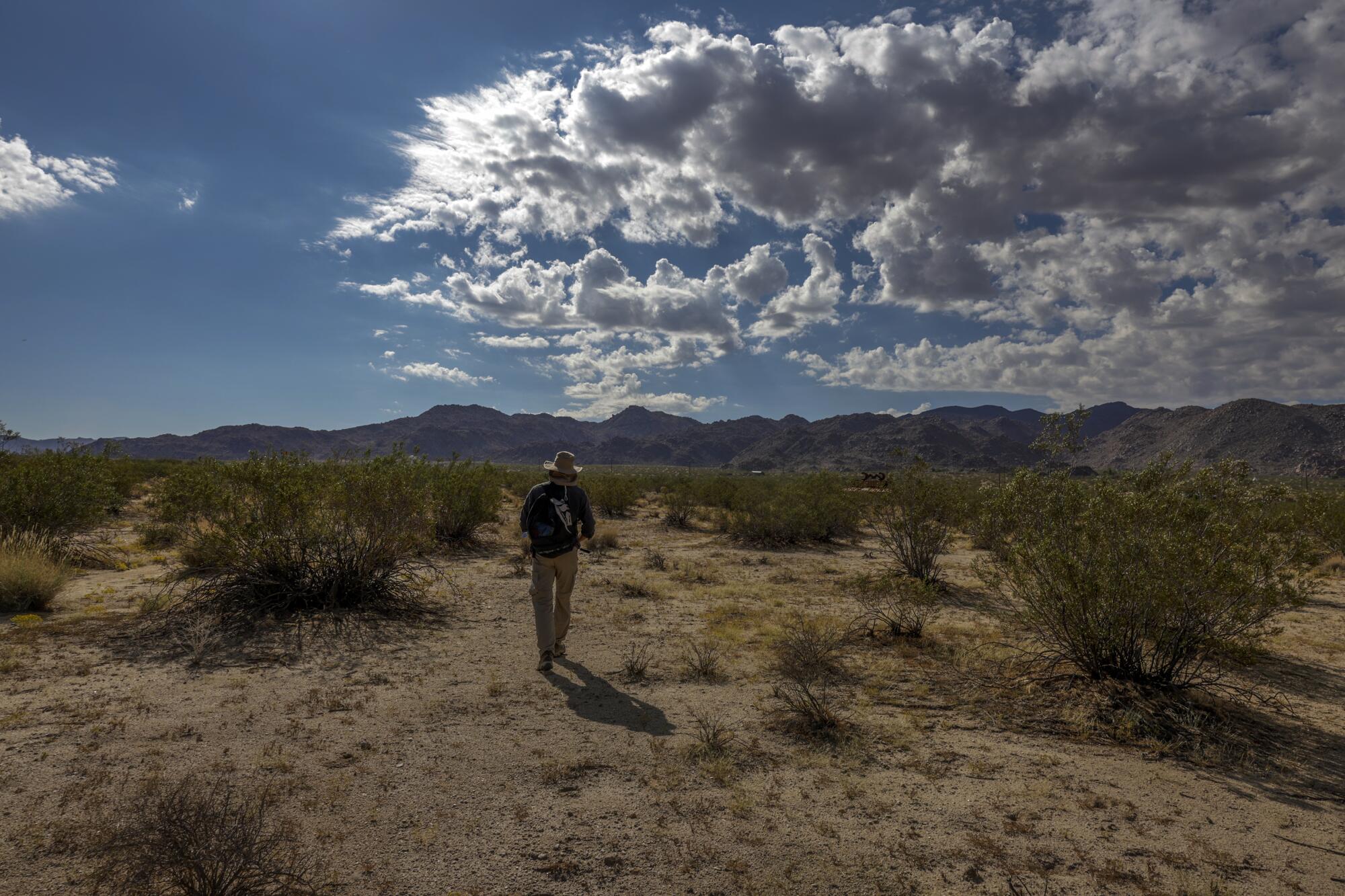
For a species that can potentially live up to 80 years, the population collapse has been sudden. In the 1950s, tortoises were still so abundant that some gas stations in desert lands hung up signs that beckoned, “A free tortoise with a fill up.”
By the 1960s, desert recreationists began roaming the desert in dune buggies and motorcycles, sometimes squashing the animals and their burrows, and kicking up dust that exacerbated the species’ propensity for upper respiratory infections.
As Southern California sprawl marched eastward, garbage and roadkill followed. The detritus nourished waves of invading ravens, who snatched up baby tortoises.
Half-dollar-size juvenile tortoises are voracious, grow fast and start digging burrows almost immediately. But such impressive survival skills are no match for the social and highly intelligent ravens.
Seven decades ago, ravens were hard to find in the desert. But their numbers exploded due to increases in food and water at landfills, dumpsters, sewage ponds, golf courses and city parks.
“Ravens are like people,” mused Cummings. “There are too damn many, and they are consuming the planet.”
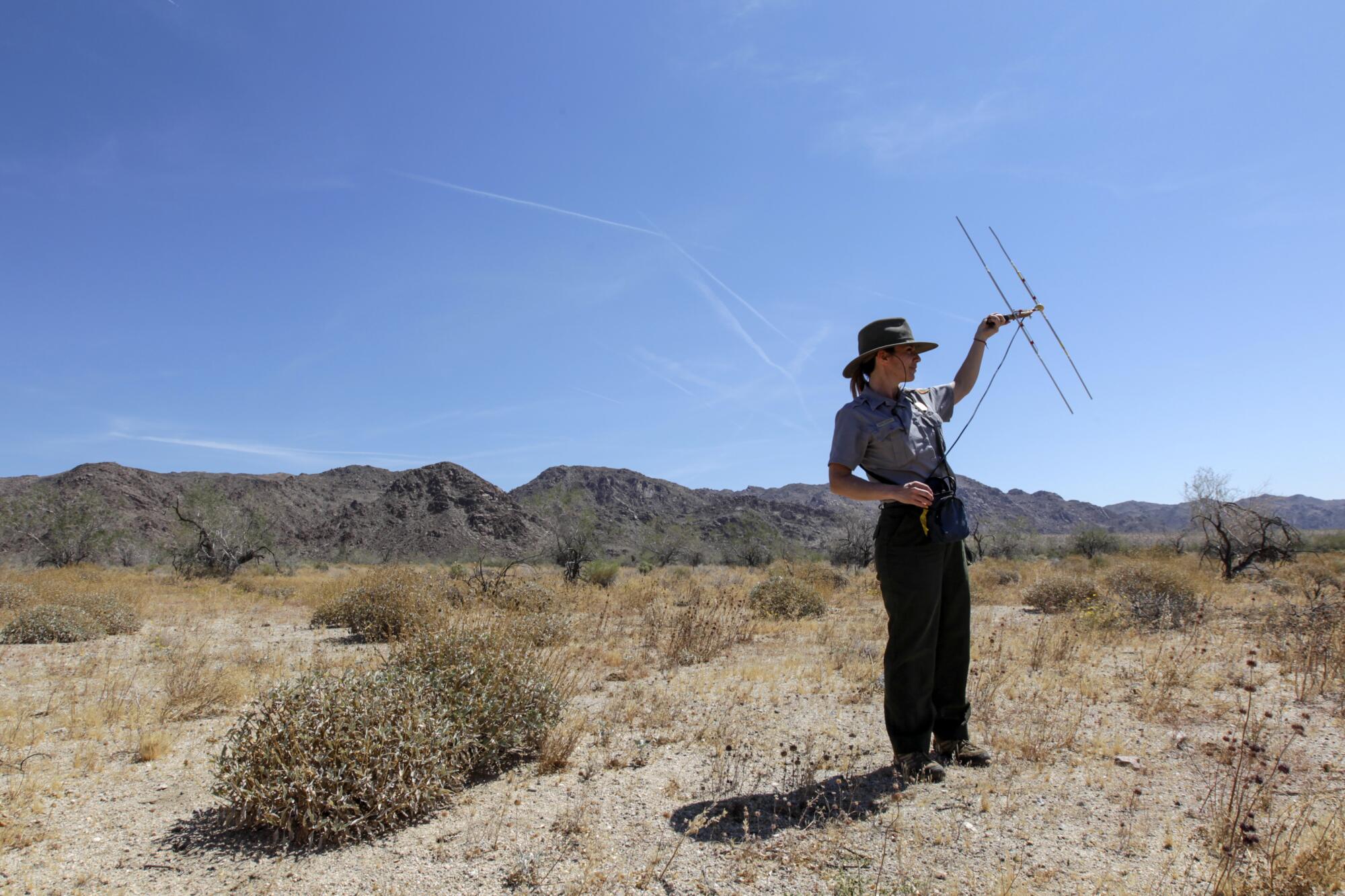
A 1994 recovery plan sought to stem the decline of desert tortoises and was revised in 2011 to correct problems that state and federal wildlife and land management agencies were having in implementing recovery strategies.
Still, the animal’s numbers have plummeted. A 2018 study estimated that there were 124,050 fewer adult tortoises within their historic range in 2014 than the 336,393 tortoises present in 2004.
“Unfortunately, many of the recovery plan’s recommendations have still not been implemented,” said Kristin Berry, a U.S. Geological Survey biologist.
Although the plan called for prohibiting “habitat-destructive military maneuvers,” substantial critical habitat was absorbed in 2008 by expanded combat exercises at the Army’s National Training Center at Ft. Irwin, about 36 miles northeast of Barstow. A subsequent $8.7-million tortoise relocation effort was hit hard by coyote attacks.
Other unfulfilled recommendations include erecting fences along stretches of desert roadways including Interstate 40 and U.S. 95, installing culverts that enable tortoises to crawl under roads, and prohibiting vehicles, grazing, gun ranges, off-road vehicles, wild burros and horses, and feral dogs.
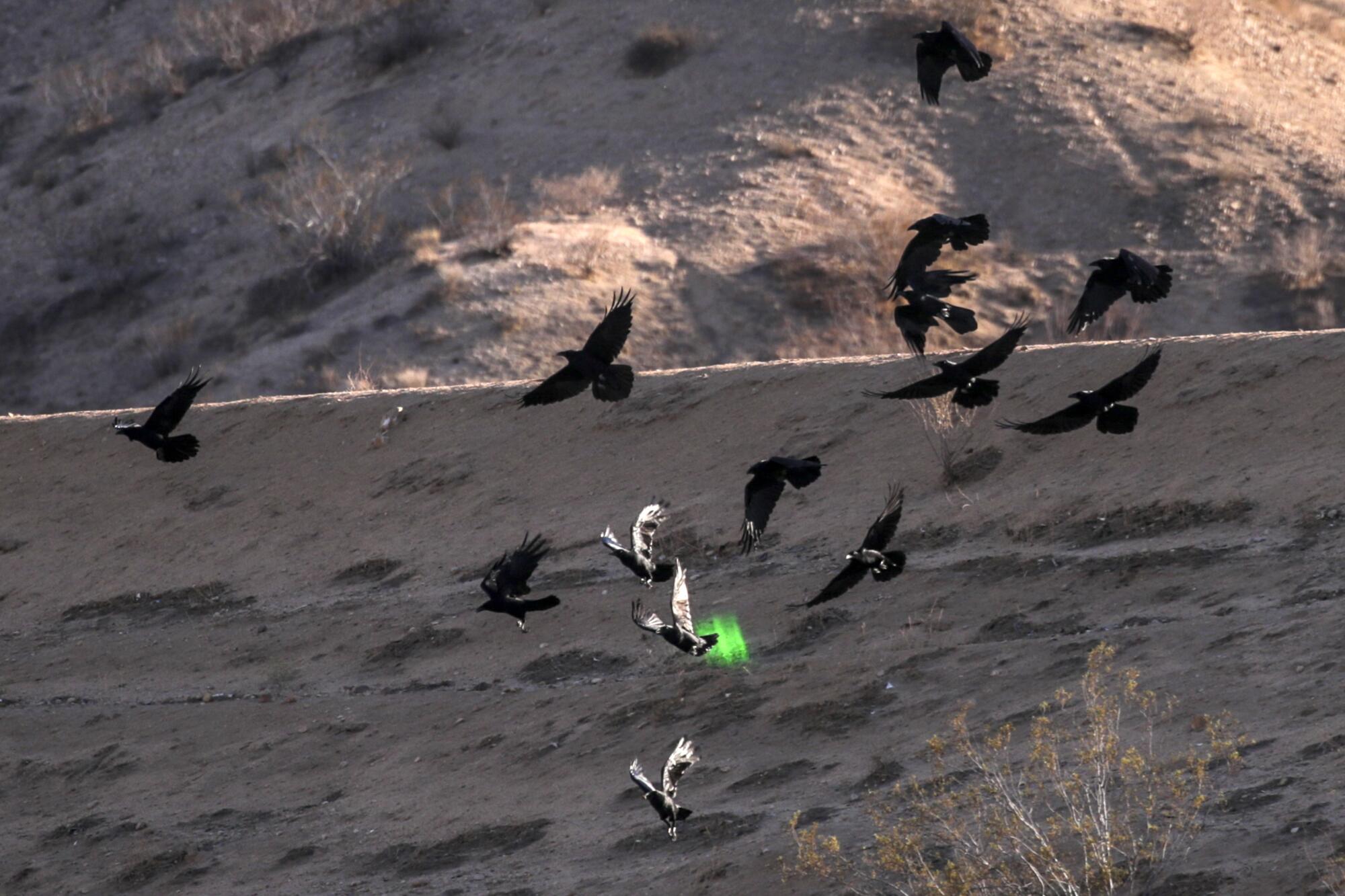
Currently, ravens pose the greatest predatory threat to desert tortoises in the desert. As a result, some biologists are waging controversial campaigns to eradicate or harass the winged intruders.
On a recent morning, the desert calm was shattered by the broken calls of ravens wheeling above a sewage treatment facility on the outskirts of Victorville.
As the birds plunged earthward to gulp water and feast on fatty globs bobbing in treatment ponds, a shadowy figure emerged from the corner of a building holding what looked to be a submachine gun.
Hoping to zap the invaders with a coherent beam of green light that deeply annoys the birds, biologist Tim Shields took aim. Before he could fire, however, raven lookouts on nearby railings twitched with alarm, signaling the others to fly elsewhere for breakfast.
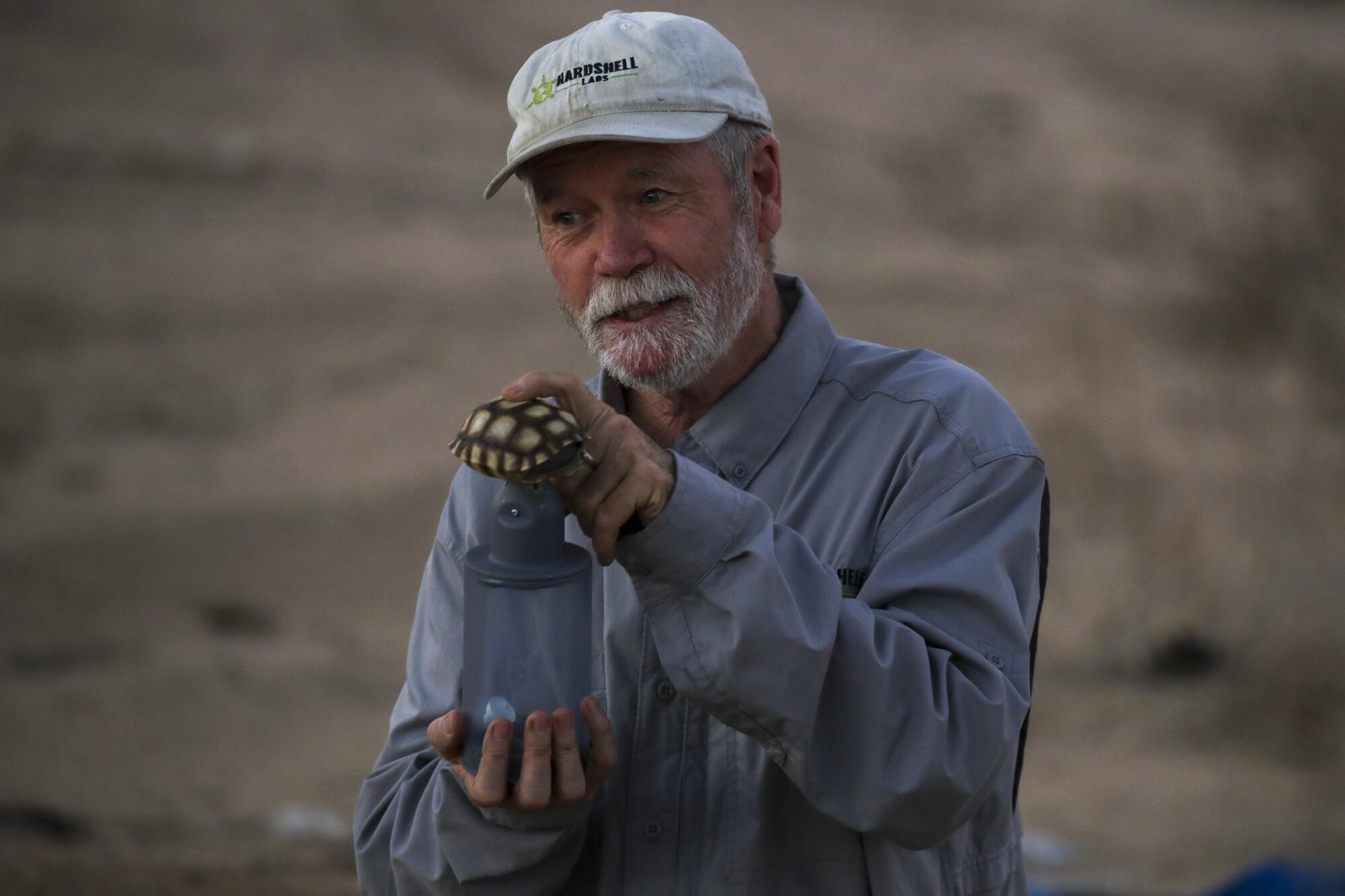
“I like ravens; they’re so incredibly smart that they recognize my truck when I arrive in the morning,” said Shields, a “raven cop” enlisted by the Victor Valley Wastewater Reclamation Authority. “But I also love tortoises too much to throw in the towel.”
In addition to lasers, Shields has deployed “techno-tortoises” — highly realistic replicas of baby tortoises that, when pecked or bitten, emit irritants derived from grape juice concentrate. He’s also flown a quadcopter that squirts streams of silicone oil into an unoccupied raven’s nest, preventing oxygen from permeating the shells of eggs, and killing the embryos within.
Although wildlife authorities say Shields’ efforts are starting to pay off in the form of reduced raven visits, they have yet to make a noticeable dent in the declining tortoise population.
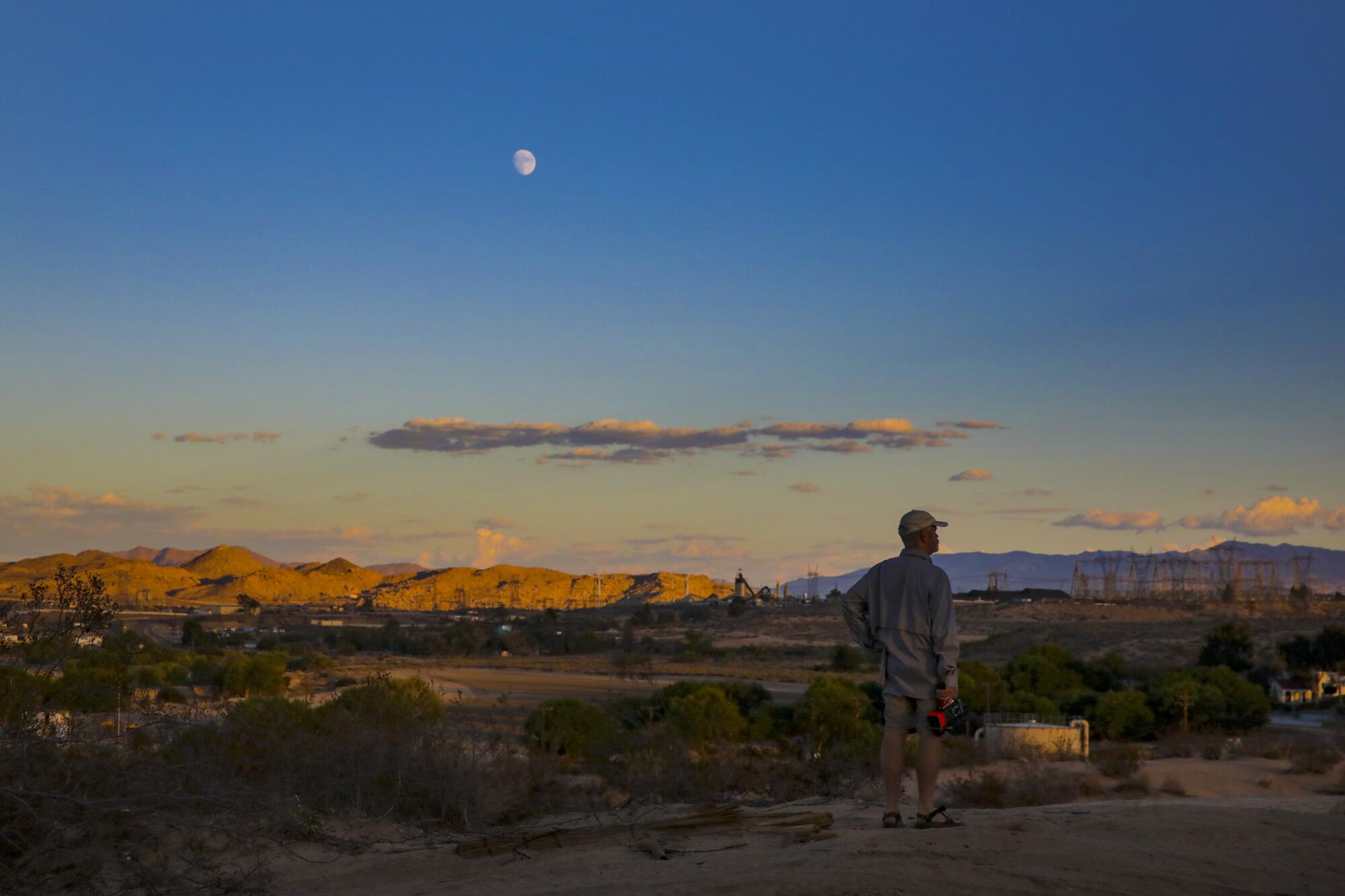
Back at the Desert Tortoise Research Natural Area, LaVelle and other researchers are advocating the installation of fences around other patches of untrammeled habitat — including areas of higher, cooler elevation, where the animals stand a better chance of surviving drought and rising temperatures due to global warming.
But that won’t be easy in a region where fences have been controversial since ranchers drove livestock over boundless terrain.
Fences can inhibit natural migration of wildlife, prevent access to critical resources during drought, and be costly to maintain. But they can also protect fragile relic populations of endangered species by excluding livestock, poachers, vehicles and development.
For LaVelle, 65, the benefits of fencing off critical tortoise habitat surrounded by desert boomtowns, freeways and solar energy facilities were obvious as she ticked off the vital statistics of the young tortoise she discovered.
“It’s a young male, perhaps three pounds,” she said. “Carapace is about eight inches in length. No scratches or bites, and in generally good shape.”
After recording the creature’s data, LaVelle gazed out across the refuge. “We try not to be anthropomorphic around here,” she said. “But I’ve already given him a nickname: Little Miracle.”
Watch L.A. Times Today at 7 p.m. on Spectrum News 1 on Channel 1 or live stream on the Spectrum News App. Palos Verdes Peninsula and Orange County viewers can watch on Cox Systems on channel 99.

